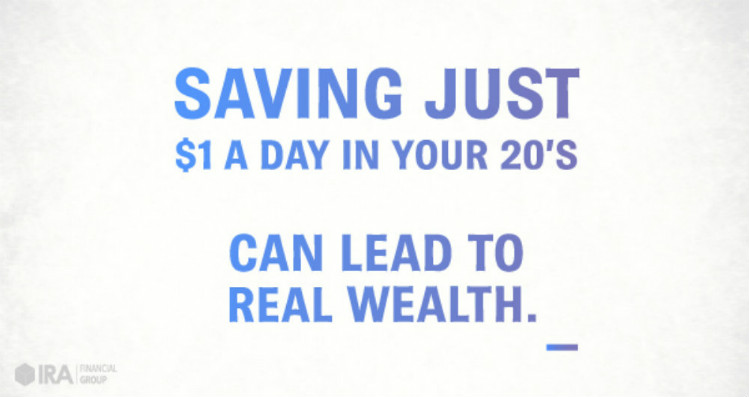If you’re a millennial (or post-millennial), one important part of life that might not be on your radar yet is retirement. After all, you probably have decades until you retire. Even though it is only a distant consideration right now, as a young adult, it’s important to start learning about the benefits of retirement accounts right now, especially the Roth IRA. The sooner you start saving for retirement, the better position you will be to face it as it approaches.
You don’t want to wake up one day and realize you’re 50 years old and have little or nothing saved for your golden years.
- Millennials should be saving for retirement right now
- The Roth IRA is a way to have a tax-free retirement
- The more you save, and the longer you save, the better off you will be
The Roth IRA Backstory
An Individual Retirement Account, or IRA, is a retirement savings vehicle that you can utilize to put aside money for when you retire. IRAs offer tax breaks, the most important thing to consider as you get older. Traditional plans offer an upfront tax deduction, but all distributions from the account are taxable later. The Roth IRA flips the tax advantages, meaning there is no tax benefit when you deposit the funds, but distributions later on will be tax free. Named for Senator William Roth (R-DEL) who, along with Senator Bob Packwood (D-ORE), introduced the concept of the “IRA Plus” or “Roth IRA.” The Taxpayer Relief Act of 1997 formally established the “Roth IRA” in the United States.
The Rules of the Roth IRA
Contributions
To fund a Roth IRA, you must have earned income during the year(s) you wish to contribute. The maximum amount you can contribute to an IRA (whether traditional or Roth) is defined by the IRS and changes almost every year. In 2023, for example, you are allowed to contribute $6,500 or the amount of income you earned that year, whichever is less. That is $500 more than taxpayers were allowed in 2022. If you are at least age 50, you are allowed to contribute an additional $1,000, commonly referred to as a “catch-up” contribution. Together, if you are age 50+, you can contribute a maximum of $7,000 in 2022, and up to $7,500 in 2023.
The most important thing to understand about a Roth IRA is that you do not get an immediate tax break for contributions. Your tax benefits come only when you take the money out as a distribution later in life. Put simply, these accounts are funded with after-tax dollars. In contrast, traditional IRAs are funded with pretax dollars. An easier way to think about this distinction is that traditional contributions occur before you get a paycheck, while Roth contributions come after your salary has been taxed and your paycheck has been received.
Another important distinction is that Roth IRAs do not come with any required minimum distributions. The government will never force you to take a distribution from a Roth IRA. In addition, you can continue to contribute to one as long as you keep earning money.

Roth Income Restrictions- The Backdoor Roth IRA Solution
Every form of retirement plan has a downside, however, and unlike traditional plans, Roth IRAs come with income limits imposed by the IRS. The rules prohibit anyone from directly contributing to a Roth if you make too much money, as defined by the IRS on an annual basis. For 2023, those limits are $153,000 for single filers and $228,000 for married filing jointly. If your income exceeds these amounts, the Roth IRA is not available for you.
However, since 2010, the IRS removed any kind of income restrictions for a procedure known as a Roth conversion. Hence, in 2022, anyone can make a Roth IRA contribution – either directly or via a backdoor Roth IRA Conversion. In essence, your income no longer has any impact on your Roth IRA limits.
The Roth IRA has a substantial advantage over other IRAs, namely once the Roth IRA has been open for at least 5 years with an owner over age 59 ½, all Roth IRA distributions are tax-free. While Roth IRA contributions are not immediately tax deductible, the opportunity to shelter all future Roth IRA gains from tax is extremely tax advantageous.
Conversions
As stated above, no limits exist as to income levels when it comes to converting traditional funds to a Roth account using our ‘backdoor’ technique. At any time and for any amount, you may simply choose to convert funds to a Roth IRA. The only caveat to using this technique is the reality that you must pay ordinary income taxes on the amount converted.
Distributions
All qualified Roth IRA distributions are tax-free. For a distribution to be qualified, you must have had the Roth account for at least five years and be 59 ½ years old. Failure to meet this criterion will lead to penalties.
The Benefits of a Roth IRA
No 401(k)/Bad 401(k)
While more and more employers are offering employees a 401(k) plan as an incentive to come work for them, not all businesses offer access to retirement plans. Further, limiting factors like choice in investment options and management fees may make a plan offered by some employers less desirable. Anyone with earned income can open and contribute to a Roth IRA irrespective of income thanks to the “Backdoor Roth IRA” solution. This is especially true for today’s “gig” worker who doesn’t work for one company.
Your Youth
Let’s face it, you’re not getting any younger, so why not let your age work for you. The earlier you start putting aside money for retirement, the more the power of compounding will work to your benefit. With a Roth IRA, that compounding will lead to a larger nest egg than saving with a traditional plan.
Tax Implications
Unless you landed your dream job and are rolling in the dough at 25, you probably haven’t even begun to approach to your peak earnings potential. Most people will earn more as life goes on. The question almost asks itself – Would you rather get a tax break now, when you’ve just entered the workforce, or later on in life when you’re making the big bucks? Each investor is different, but considering the theorem that you’ll earn more later, it’s typically better to take your lumps when it comes to taxes now than later.
Emergency Fund
Some financial planners argue that you should always have three to six months’ salary set aside for an emergency. We agree. But here’s one thing that you may not know – a Roth IRA can be used for an emergency, or for any other reason. Any contributions you make to a Roth can be withdrawn at any time and for any reason without being hit with a hefty tax bill or early withdrawal penalties. Importantly, however, this is only true for contributions, not for earnings. For example, if you contribute $10,000 and your investment earns $5,000 over time, you may only withdraw the $10,000 contribution penalty-free. The $5,000 in earnings would come with penalties upon withdrawal.
Stretch it out
Since you are never required to take distributions from your Roth IRA, it serves as the optimal estate planning tool. You can elect to pass your tax-free IRA on to your heirs, or, if your spouse is the beneficiary, he or she can assume it as his or her own and continue to contribute. If you leave it to a non-spouse (such as a child), he or she will be subject to minimum distribution requirements, but they should remain tax-free.
Millennial Roth IRA – Examples
Sophia is 28 years old and makes a Roth IRA contribution of $4,500 every year until she reaches age 70. Let’s assume she is in the 30% tax bracket and earns 9.5% on her investments. When she retires at 70, her Roth IRA account would be worth a whopping $4,097,156. On the other hand, if Sophia had made the same contribution for the same amount of time though a taxable account, the account would be worth a mere $1,408,347.
Jen is 23 years old and makes a $365 ($1/day) annual contribution to a Roth IRA until she reaches age 70. Let’s assume she is also in the 30% tax bracket and earns 7.5% on her investments. When she retires at 70, her Roth IRA account would be worth $151,385. If Jen had made these $365 contributions though a taxable account, the account would only be worth $73,740.
Josh is 25 years old and contributes $1,825 ($5/day) to his Roth IRA each year until he reaches age 70. Josh is in the 30% tax bracket as well and earns 8% on his investments. When he retires at 70, his Roth IRA account would be worth $761,803. If Josh had made these $1,095 contributions though a taxable account, the account would only be worth $365,176.
Conclusion
The Roth IRA is a legal tax shelter that millennials and anyone earning income in the United States can take advantage of. The ability to generate tax-free income is the ultimate tax shelter, and the Roth IRA is an excellent tool to accomplish these goals. Taking advantage of the power of the Roth IRA requires four requirements: (i) start making contributions early, (ii) be consistent, (iii) have patience, and (iv) trust the process. The examples above clearly demonstrate that one does not have to be a high-income earner to generate massive retirement growth.









